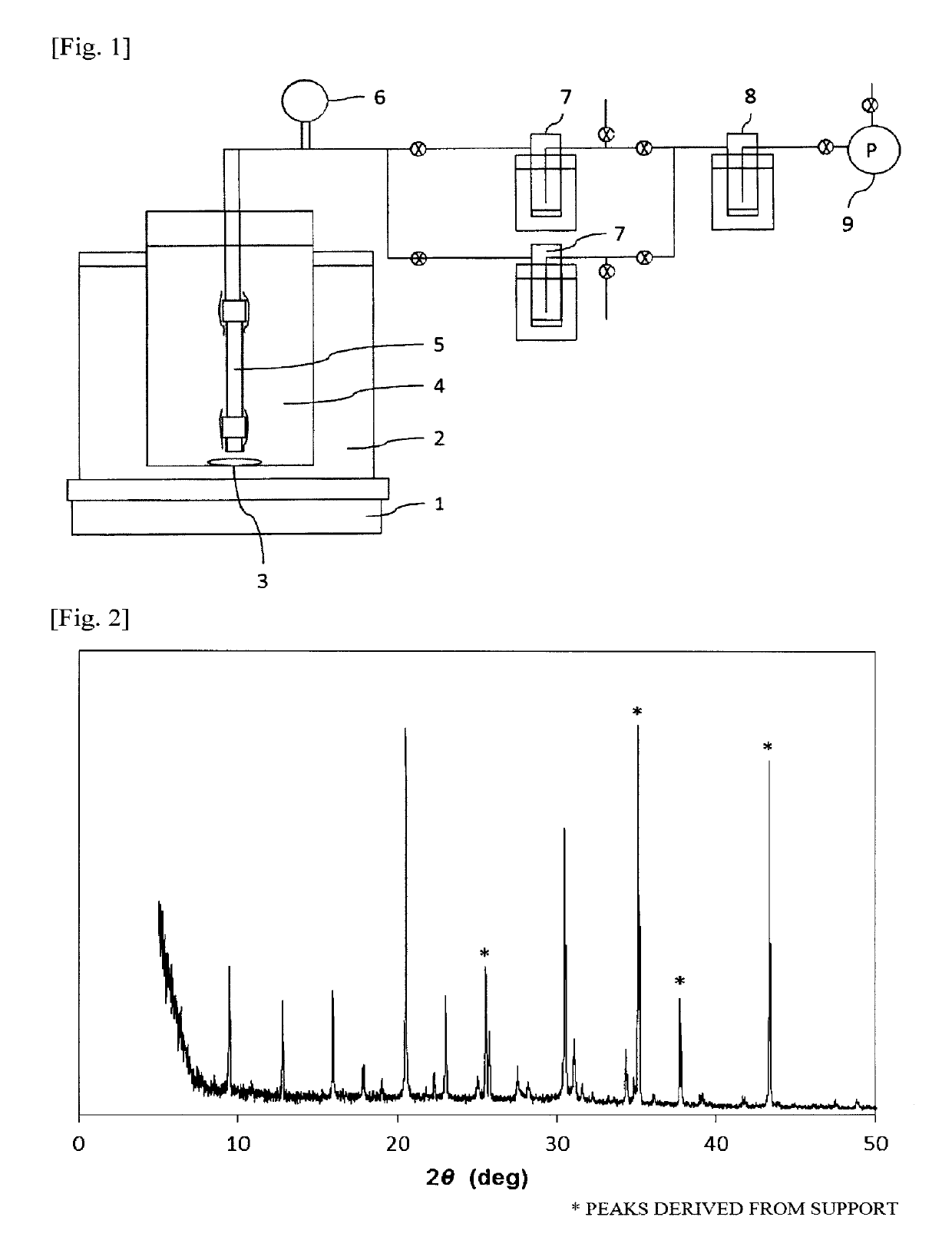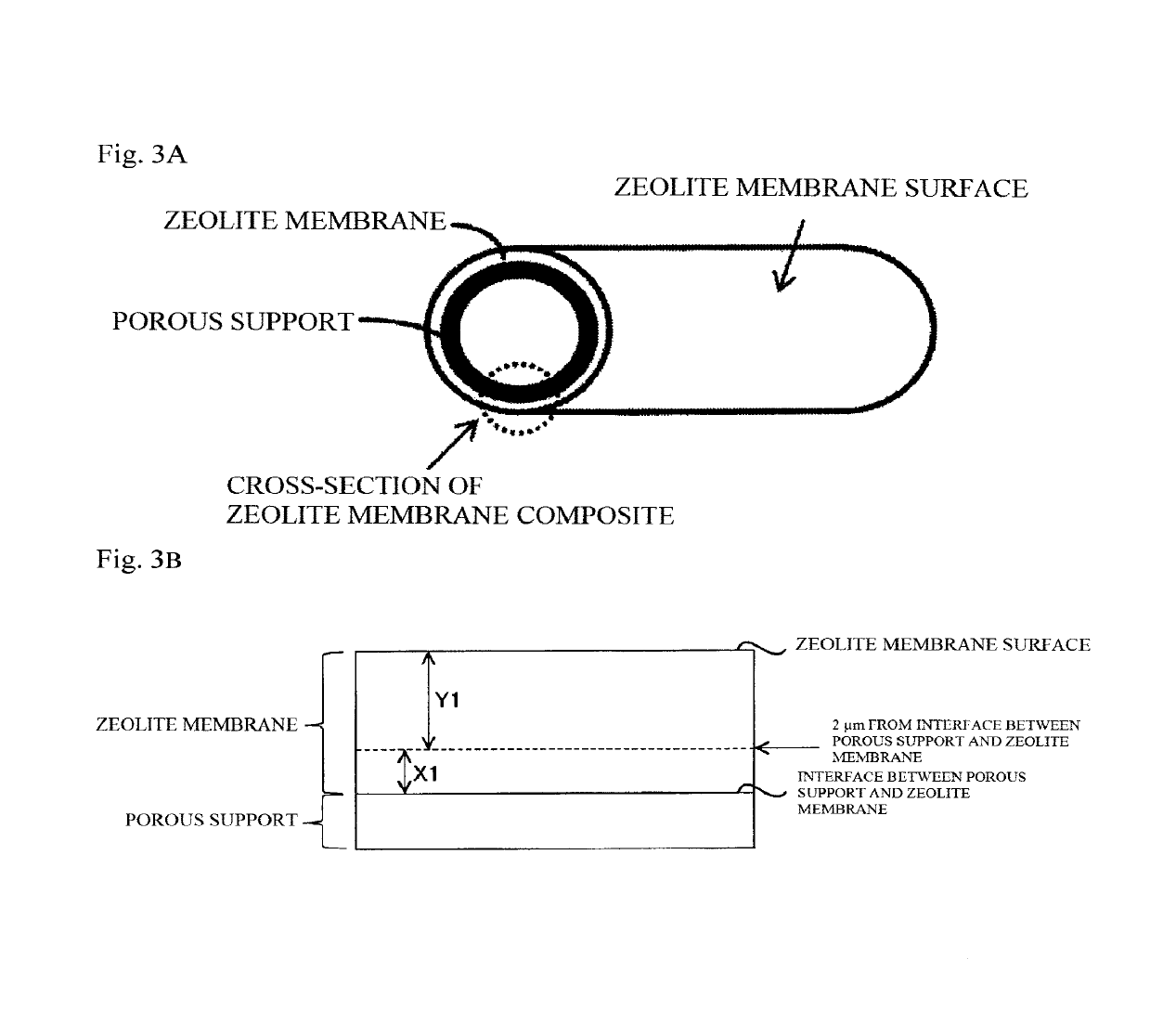Porous support-zeolite membrane composite
a technology of porous support and zeolite, which is applied in the direction of membranes, distillation, separation processes, etc., can solve the problems of poor chemical high energy requirements, and low heat resistance of polymer membranes, and achieve good acid resistance and water resistance, short time period, and sufficient permeation flux
- Summary
- Abstract
- Description
- Claims
- Application Information
AI Technical Summary
Benefits of technology
Problems solved by technology
Method used
Image
Examples
example 1
[0202]The following mixture was prepared as an aqueous reaction mixture for hydrothermal synthesis.
[0203]To 2.15 g of aluminum hydroxide (containing 53.5% by mass Al2O3; manufactured by Aldrich Co.) were added 63.0 g of 1 mol / L aqueous KOH solution and 61.8 g of water. The ingredients were mixed together by stirring to dissolve the solid and obtain a solution.
[0204]Thereto was added 13.5 g of colloidal silica (Snowtex 40, manufactured by Nissan Chemical Industries, Ltd.). This mixture was stirred for 2 hours to obtain an aqueous reaction mixture.
[0205]This aqueous reaction mixture had the following makeup (molar ratios): SiO2 / Al2O3 / KOH / H2O=1 / 0.125 / 0.7 / 80 and SiO2 / Al2O3=8.
[0206]As an inorganic porous support, use was made of one obtained by cutting a porous alumina tube (outer diameter, 12 mm; inner diameter, 9 mm) into a length of 80 mm, subsequently cleaning the cut tube with an ultrasonic cleaner, and then drying the cleaned tube.
[0207]A mixture of 10.0 g of a Y type zeolite in th...
example 2
[0211]The same aqueous reaction mixture, inorganic porous support, and seed crystals as in Example 1 were used.
[0212]The support was immersed, for a given time period, in a dispersion obtained by dispersing the seed crystals in water so as to result in a concentration of 2% by mass. Thereafter, the support was dried at 100° C. for 5 hours or longer to adhere the seed crystals thereto. As a result, the mass of the seed crystals adhered was 2 g / m2.
[0213]The support to which the seed crystals had been adhered was immersed in the aqueous reaction mixture and the temperature was raised, in the same manner as in Example 1. A porous support-zeolite membrane composite was then obtained in the same manner as in Example 1, except that after completion of the temperature rising, the contents were heated at 180° C. for 18 hours in a stationary state under a spontaneous pressure.
[0214]The porous support-zeolite membrane composite which had been dried had an air permeation rate of 0 L / (m2·h). The...
example 3
[0216]The same aqueous reaction mixture and seed crystals as in Example 1 were used.
[0217]As an inorganic porous support, use was made of one obtained by cutting a porous alumina tube (outer diameter, 16 mm; inner diameter, 12 mm) into a length of 80 mm, subsequently cleaning the cut tube with an ultrasonic cleaner, and then drying the cleaned tube.
[0218]The support was immersed, for a given time period, in a dispersion obtained by dispersing the seed crystals in water so as to result in a concentration of 2% by mass. Thereafter, the support was dried at 100° C. for 5 hours or longer to adhere the seed crystals thereto. The mass of the seed crystals thus adhered was 0.3 g / m2.
[0219]The subsequent procedure was conducted in the same manner as in Example 1 to obtain a porous support-zeolite membrane composite.
[0220]The porous support-zeolite membrane composite which had been dried had an air permeation rate of 39 L / (m2·h).
[0221]The SiO2 / Al2O3 molar ratio thereof was determined through ...
PUM
| Property | Measurement | Unit |
|---|---|---|
| molar ratio | aaaaa | aaaaa |
| molar ratio | aaaaa | aaaaa |
| pore size | aaaaa | aaaaa |
Abstract
Description
Claims
Application Information
 Login to View More
Login to View More - R&D
- Intellectual Property
- Life Sciences
- Materials
- Tech Scout
- Unparalleled Data Quality
- Higher Quality Content
- 60% Fewer Hallucinations
Browse by: Latest US Patents, China's latest patents, Technical Efficacy Thesaurus, Application Domain, Technology Topic, Popular Technical Reports.
© 2025 PatSnap. All rights reserved.Legal|Privacy policy|Modern Slavery Act Transparency Statement|Sitemap|About US| Contact US: help@patsnap.com


